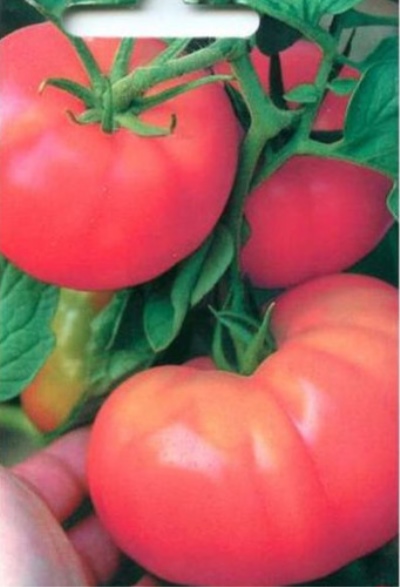
- Authors: A. N. Kononov, L. G. Krasnikov ("Biotechnics")
- Year of approval: 2002
- Category: grade
- Growth type: determinant
- Appointment: fresh consumption
- Ripening period: ultra early
- Ripening time, days: 83
- Growing conditions: for open ground, for film greenhouses, for closed ground
- Bush height, cm: 80-90
- Bush characteristic: semi-spreading
Low-growing varieties of tomatoes rarely bear large fruits. But this does not apply to the Leningradsky Giant variety. Stretching no more than 90 cm, it produces large and sweet tomatoes.
Breeding history
Work on the variety in the early 2000s was carried out by specialists from the well-known seed-growing company "Biotekhnika" (St. Petersburg) A. N. Kononov, L. G. Krasnikov. The culture was included in the State Register in 2002. Since then, the tomato has been grown in garden plots, home gardens and small farms under film shelters.
Description of the variety
The plant of the determinant type of growth is not a standard plant. The bush is semi-spreading, compact, medium-branched, can reach a height of 80–90 cm. The leaves are carved, rather large, the color is green. The first of the simple inflorescences is formed over the 7th leaf, then they are laid after 1-2 leaves. The fruits of the variety are resistant to cracking. The positive qualities of culture include:
- early fruiting;
- large fruits;
- original colors;
- great fruit taste.
The main qualities of the fruit
Given its short stature, the Leningrad giant forms rather large fruits: on average about 120 g. But there are also more weighty specimens up to 300 g. Medium-silver fruits have a flat-round shape. Unripe berries are painted green, there is a dark green spot in the area of the stalk. Ripe tomato has a beautiful pink color. The number of seed chambers is different; fruits with both 3 and 4 nests are found.
Taste characteristics
Leningradsky Giant tomatoes are distinguished by their high taste, which tasters evaluate as excellent, dessert, since the fruit tastes sugary. According to its purpose, the variety is salad.
Ripening and fruiting
The fruits of the Leningrad giant ripen on 83 days after full germination. Therefore, it is considered ultra-early.
Yield
The yield of the described variety is expressed in the figure of 4 kg / sq. m.
The timing of planting seedlings and planting in the ground
The Leningrad giant is grown by the seedling method. Therefore, at the end of March, it is necessary to start sowing seeds for seedlings. And transplanting plants into the ground can be carried out in May or June, depending on the weather conditions in a particular area.

Growing tomato seedlings is an extremely important process, because it largely depends on whether the gardener will be able to harvest at all. All aspects must be taken into account, from seedbed preparation to planting in the ground.
Landing scheme
To get the most out of growing the Leningradsky Giant variety, on an area of 1 sq. m, you can not place more than 3 bushes of culture.

Growing and care
Seedlings of the Leningrad giant can be planted in the ground when the ground warms up to +25 ºС. Before the direct planting of high-quality tomato seedlings, it is necessary to add 1 tablespoon of a mixture of potassium sulfate and superphosphate to each hole.
Planting requires special care. So, when cultivating tomatoes of the described variety, irrigation should be done only in severe drought. Plants form 1–2 trunks, and no more than 3–4 clusters should remain on each stem. Although the plants are short, a tie to support the heavy fruit is necessary.
During the period when the fruits begin to set and form, it is necessary to feed the plant with potassium sulfate, and during ripening, old leaves should be regularly cut off. The rest of the cultivation of varietal tomato is no different from caring for other varieties of nightshade crops.




A plant needs different micronutrients at each stage of growth. All fertilizers can be divided into two groups: mineral and organic. Folk remedies are often used: iodine, yeast, bird droppings, eggshells.
It is important to observe the rate and period of feeding. This also applies to folk remedies and organic fertilizers.


Growing regions
The Leningradsky Giant variety can be successfully grown throughout Russia in regions such as:
- North and Northwest;
- Central and Volgo-Vyatka;
- Central Black Earth and North Caucasian;
- on the Middle and Lower Volga;
- in the Urals and Siberia;
- in the Far East.

























































































